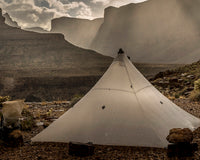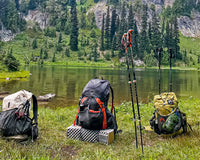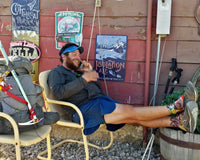
Himali Apparel co-founder. Nepali native. Lifelong mountaineer. All are accurate descriptions of the prolific Tendi Sherpa. But upstage, one astounding statistic outdoes the rest: 12-time Everest summiter. And it can be easy to stop at this fact alone. The mere idea of reaching the 8,848m summit not once but twelve times since 2004 can seem like an almost unfathomable feat to most.
But Tendi’s journey as sherpa did not simply begin with the trials of base camp, and seeing him reach the summit reveals only the front end of a time-tested and watertight framework for success. From childhood porter treks to 12-and-counting Everest summits, Tendi has cultivated a deep intuition and respect for traversing the Himalayas. Through his mountain mettle, Tendi has since translated his fine-tuned climbing acumen onto apparel engineered to deliver the same level of dependability, efficiency, adaptability, and resilience that he himself provides.

The Lay of the Land
In 1983, Tendi was born in Khembalung, Nepal, a tiny village at 2500m elevation nested within the dense forests of Makalu National Park. Lacking key facilities, including hospitals and schools, meant that diligence was key to a sustainable lifestyle for Tendi and his family. It also meant that receiving an education required serious commitment: “At five years old, I was the first child in my village to enroll in school. It took a two day walk crossing the dense forest . . . I exchanged work for free food and lodging, and so I arrived at school around 3-4 hours late. I told my teacher I had no other options, but punishment became a normal part of my education.”
After three years of labor and unjust schooling far from home, he felt compelled to return to his family. On the last legs of his journey he faced an untouched river system, the final obstacle before reaching his village. After a misstep he fell straight into the river, pushing him to the other side. He regained consciousness with just his head above water on the shore and crawled home soaked. This experience firmly planted a seed in Tendi, which soon evolved into an ardent desire to bring back prosperity to his community.

A Long Way Up
“I went to Kathmandu barefoot. I didn’t even know sandals or shoes existed.” Even when he felt pressured to buy them for his porter responsibilities, he often took them off, pushing forward foot to earth, even when that earth was at elevations breaking 5,000m. Indeed, “life was not as easy as expected. I trekked for days around the Annapurna, took 34 days on foot carrying 43 kg every day, 10-16 hours a day, all with a head strip,” meaning he secured the entire packing load on top of his head using just a band of cloth.
With a bit of luck and fortitude, Tendi, then age nineteen, landed a job as an Everest guide. As exciting as it was daunting, this new era of climbing brought with it a slew of new techniques, safety considerations, and objective dangers that he quickly familiarized himself with, nearly at the expense of his life:
“I was on the south side and almost fell into a 70m deep crevasse. . . . even this year, one guide died from falling in it, and this same crevasse was hidden to me and I slipped in." Reflexively he shot his hands out to grip the ledges and his friend pulled him out. But with ice pinnacles trained on him from the sightless bottom, a plummet would’ve meant certain death.
After this experience, Tendi began reevaluating the stakes of his operation. “At the beginning, we only thought of reaching the top… always we talked and dreamed about the summit, but we never talked about what could happen when . . . there’s bad weather, unexpected crevasses. . . . I tell my team not to get too excited on the summit: only once the job is entirely completed. Then you can celebrate.”
Evidently, the descent imposes just as many difficulties as the approach, and Tendi’s caution is rooted in more than just concern for his climbing teams: often the financial stability of a sherpa’s family is hinged upon their completion and return from expeditions. This reliance has caused a lot of distress for many sherpas—from porters to Everest pros. “I’ve known parents who’ve had to withdraw their children from school and go back to the village for farm labor,” he laments. And with unpredictability so baked into the daily routine, Tendi identified a need for good, accessible gear—apparel aptly attuned to the demands of serious expeditioners.

Himali: “People of the Himalayas”
“Since the beginning . . . I was always very curious and fascinated by clothing” Either through neighborly fate or pure coincidence, Tendi stumbled upon his future business partner Dave Schaeffer, a Colorado native, while working as a guide on Aconcagua in 2012. After months of planning, they established Himali, an ultralight, ultra-optimized outfitter with a name meaning people of the Himalayas—acting as a driving insignia behind Tendi’s long-term vision: to stimulate and bring benefit back to the economic climate of Nepal.
Within and independent of his company’s outreach efforts, Tendi has never been one to talk without the walk: “I had been doing a lot of social work in my home village, and my first undertaking was to build a suspension bridge over the river where I was almost killed when I was seven years old.” After weeks of hauling and hammering, Tendi saw for the first time people convey so effortlessly across his first natural obstacle. “It gives me great relief . . . that the children in the village won’t have to face the same situation as I did when I was a kid.”

Above: The bridge situated outside of Tendi's home village, made in partnership with Nepalko Sathi Association, Switzerland
But the scope of restorative measures goes far beyond Tendi’s birthplace: “Himali has always been invested in the Clean Water Project for Kathmandu. . . . A lot of people die every year from water pollution. At the moment we can’t help a lot but every proceed from our sellings we put into this water project.” And in addition to these provisional efforts, Himali brand looks to connect with yak herders in west Nepal and cultivate partnerships for a new wool-based apparel line, thus establishing a direct connection between Himali’s manufacturing process and the underdeveloped regions of the rural Himalayas.
When playfully prompted with the question of what animal he identifies most with, Tendi says, “A yak. They’re quite dangerous, but quite kind as well.” Yaks have been embedded in the Himalayan frontier for as long as rock has been climb-able. Born into the same conditions, Tendi pushes for real, honest change in his communities both abroad and domestic. Yak wool on his back or not, Tendi’s cut from a different cloth, and he strives to bring those fabrics in top form to both the outdoor community at large, and to the people whose very livelihoods will find crucial benefit from them.















1 comment
Burp
I really enjoyed this Article about Tendi.
What a special person!
Thanks to the author.